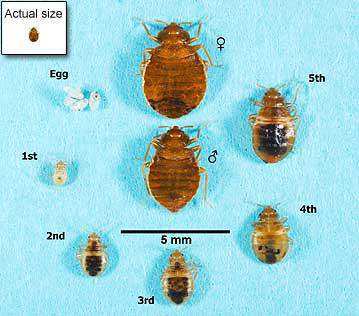What Are Bed Bugs?
Bed bugs are insects that feed on human blood, usually, they bite at night. They can cause health issues like allergies, psychological effects, skin rashes, etc. Bed bugs can be confused with other bugs. So, you should know what exactly bed bugs look like and how to get rid of them. Bed bugs are oval-shaped, small brownish insects, an adult bed bug is the size of an apple seed. Bed bugs can quickly move on floors, walls, and ceilings but can’t fly. Over a lifetime female bedbugs may lay hundreds of eggs.
Table of Contents
ToggleYoung bed bugs are called Nymphs. Nymphs shed their skin 5 times before maturity and each time they shed skin, they require blood. In good living conditions, an immature bug reaches maturity in a month and produces 3 or more times in a year. Though bed bugs cause allergies and skin rashes, they are not considered to transmit diseases.
Types Of Bed Bug
According to Terminix
There are less than 90 species of the bloodsucking insect family, Cimicidae. Of these, only three feed on humans: Cimex hemipterus, Leptocimex boueti and Cimex lectularius. The most common species of bed bug is C. lectularius. It is the cause of almost all infestations in the United States.
The common household bed bug i.e. Cimex lectularius is found around the world. Bed bugs adjust well to human environments and normally live in temperature areas.
Cimex hemipterus also feeds on humans but prefers tropical areas. They also feed on birds, rats, dogs, and other mammals.
In tropical regions or more temperature areas bat bugs (Cimex adjunctus) are also present. They usually feed on bats as the name shows, but they can feed on human blood also.
Mexican chicken bug (Haematosiphon inodora) is usually found in poultry farms and prefers birds. Leptocimex boueti is found in South America and West Africa and usually feeds on bats and birds.
It is necessary to identify bed bugs before treating any infestation. Incorrect control methods can be harmful. It is difficult to distinguish between bed bugs. You should contact the local pest control experts for consultation and inspection of your home.
How To Find And Identify Bed Bugs
To find bed bugs in your home, first, you have to know how they look. We have described the shape and types of bed bugs above. Here we will discuss it further. Many bugs may look like bed bugs.
Appearance Of Bed Bugs (Cimex lectularius), How Do Bed Bugs Look?
- Adult bed bugs are usually the size of an apple seed—approximately 5 to 7 mm.
- Long and brown, oval-shaped, and have a flat body.
- Bed bugs are smelly with a musty-sweetish odor produced by glands on the lower side of the body.
- Young bed bugs (Nymphs) are smaller and whitish-yellow in color.
Life Cycle of Bed Bugs

The picture above shows the life cycle of bed bugs (counterclockwise). Bed bugs go through these stages during their lifetime.
Where Do Bed Bugs Hide?
Bed bugs can enter your home with clothing, used beds, luggage, and other items. Their small size helps them to hide in tiny and small spaces. Bed bugs do not live in nests like bees or aunts. They live in groups and generally hide in bed frames, mattresses, box springs, and headboards where they have easy access to their victim. Along with time they may scatter to other places in the room or other rooms.
When Do Bed Bugs Bite?
Mainly bed bugs are active in the night when their victim is sleeping. Like mosquitos, they have elongated beaks and pierce the skin using the beak and suck the blood of the victim. Bed bugs feed from 3 to 10 minutes and then crawl away from the victim.
Firstly the bed bug bites are painless and after some time turn into itchy welts. You can not recognize the bug from the bite may its a mosquito or some other bug. You have to find bed bugs to actually confirm the bites.
How to Find Bed Bugs?
Now we know how bed bugs look and where to find them. You can take the following steps to identify the presence of bed bugs in your room or apartment.
- If you are coming from a trip and have luggage with you. Check your luggage before unpacking.
- When you walk into the room, take a deep breath. You will notice a sweet musty odor if there is a heavy infestation.
- Check for bed bugs in common hiding places. And look for small red or brownish bugs.
- Check the bed, sheets, pillows, and blanket. Also, check mattress pads and spring boxes and look for bed bugs. Look for specks of blood on these things.
- Inspect for bed bugs underneath the furniture and between the cushions.
- Inspect the perimeter of the room and see if you find any signs of bed bugs or their remains.
- Look for shell-like remains on the bedding and furniture.
- Check for blackish specks on bedding, furniture, and headboard. Blackish specks could be the excrement of bed bugs.
- Look for bed bug eggs on bedding, furniture, and headboard.
- Check the folds of the fabric curtains.
- Inspect for bed bugs in less common areas of the room, like beside the tables and underneath the desks.
- Look for bed bugs in Electrical items like switchboards and under lamps etc.
- Inspect for bed bugs under the rugs and carpet.
- If you have wallpaper in the room, peel the loose wallpaper and look for any remains of bed bugs.
- Inspect the clothes you piled up for laundry.

